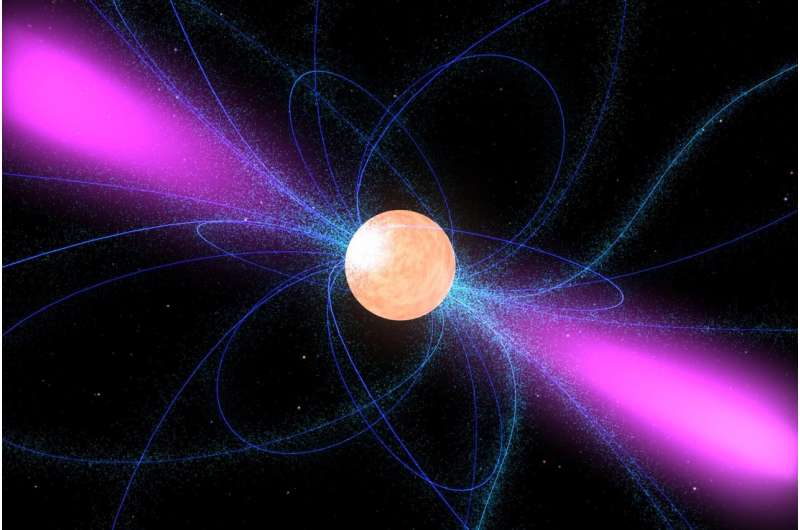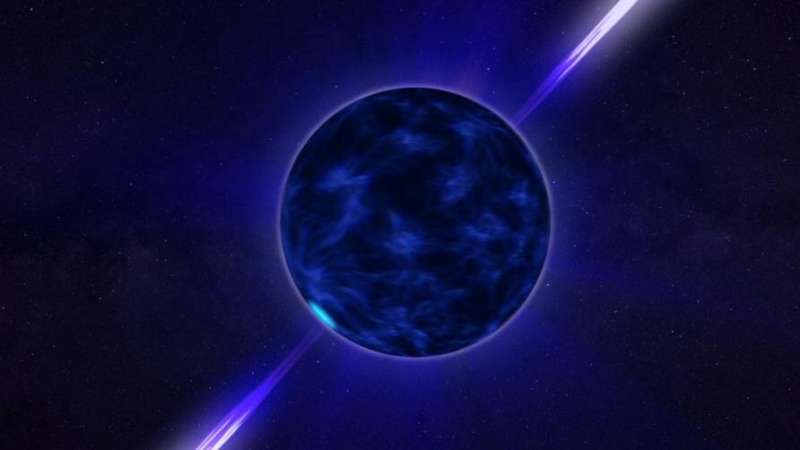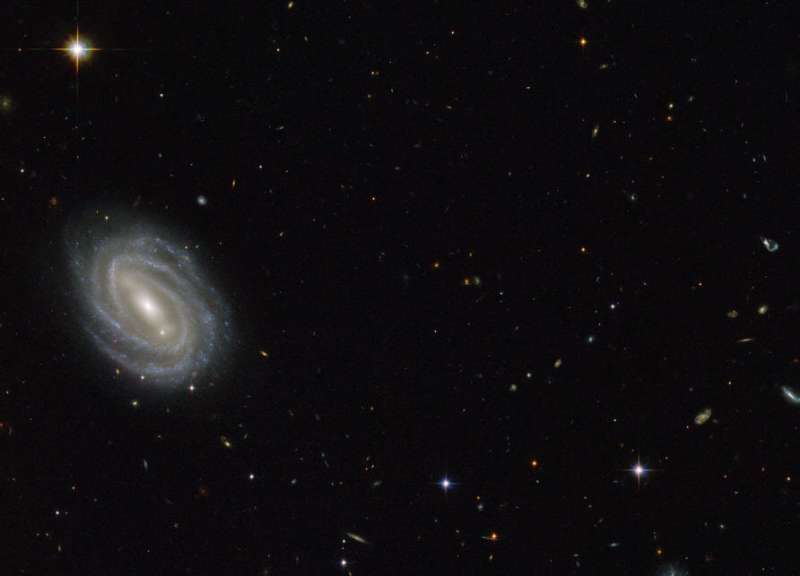Illustration showing gamma-rays from a neutron star. Credit: NASA
The quest to uncover the nature of dark matter is one of the greatest challenges in science today, but the key to finally understanding this mysterious substance may well lie in the stars.
Or to be precise, one particular type of star—the neutron star.
So far, scientists have been able to infer the existence of dark matter, but not directly observe it. Actually detecting dark matter particles in experiments on Earth is a formidable task, because the interactions of dark matter particles with regular matter are exceedingly rare.
To search for these incredibly rare signals, we need a very large detector—perhaps so big that it is impracticable to build a detector large enough on Earth. However, Nature provides an alternative option in the form of neutron stars—an entire neutron star can act as the ultimate dark matter detector.
In research published in Physical Review Letters, we have determined how to much more accurately use information gained from these unique natural dark matter detectors.
Neutron stars are the densest stars known to exist and form when giant stars die in supernovae explosions. Left behind is a collapsed core, in which gravity presses matter together so tightly that protons and electrons combine to make neutrons. With a mass comparable to that of the Sun—compressed into a 10km radius—one teaspoon of neutron star material has a mass of about a billion tons!
Neutron stars are dense enough to capture dark matter. Credit: NASA
These stars are "cosmic laboratories," enabling us to study how dark matter behaves under extreme conditions that cannot be replicated on Earth.
Dark matter interacts only very weakly with ordinary matter. For example, it can pass through a light-year of lead (about 10 trillion kilometers) without being stopped. Incredibly, however, neutron stars are so dense that they may be able to trap all dark matter particles that pass through them.
Theoretically, the dark matter particles would collide with neutrons in the star, lose energy, and become gravitationally trapped. Over time, dark matter particles would accumulate in the core of the star. This is expected to heat up old, cold, neutron stars to a level that may be in reach of future observations. In extreme cases, the accumulation of dark matter may trigger the collapse of the star to a black hole.
This means that neutron stars may allow us to probe certain types of dark matter that would be difficult or impossible to observe in experiments on Earth.
On Earth, dark matter experiments look for tiny nuclear-recoil signals, caused by incredibly rare collisions of slow-moving dark matter particles. In comparison, the strong gravitational field of a neutron star accelerates dark matter to quasi-relativistic speeds, resulting in much higher energy collisions.
Another problem for Earth-based detection is that nuclear-recoil experiments are most sensitive to dark matter particles that have a similar mass to atomic nuclei, making it harder to detect dark matter that might be much lighter or heavier.
While the existence of dark matter has been inferred, it has yet to be directly observed. Credit: NASA
However, dark matter particles can theoretically be trapped in stars and planets in considerable amounts, regardless of how light or heavy they are.
A critical challenge in using neutron stars to detect dark matter is ensuring that the calculations scientists use, fully account for the unique environment of the star. Although the capture of dark matter in neutron stars had been studied for decades, existing calculations have missed important physical effects.
So our team set about making key improvements to the calculation of the dark matter capture rate—i.e., how fast the dark matter accumulates in neutron stars—which changed the answers considerably.
Our research correctly accounts for nucleon structure, rather than treating the neutrons as point particles, and includes the effects of strong forces between nucleons, rather than modeling the neutrons as a free gas of particles. This built upon our earlier work in which we incorporated the composition of the star, relativistic effects, quantum statistics and gravitational focusing.
Put simply, we showed how to correctly think about dark matter collisions in the extreme neutron star environment, which is so very different to dark matter detectors on Earth.
This new research greatly increases the accuracy and robustness of our estimates of the dark matter capture rate. This paves the way for us to better determine the strength of dark matter interactions with ordinary matter.
Ultimately, evidence (or lack of evidence) of dark matter accumulation in stars would provide valuable clues about where to target experimental efforts on Earth, helping to unlock the mystery of dark matter.
More information: Nicole F. Bell et al, Nucleon Structure and Strong Interactions in Dark Matter Capture in Neutron Stars, Physical Review Letters (2021). DOI: 10.1103/PhysRevLett.127.111803
Journal information: Physical Review Letters
Provided by University of Melbourne


























